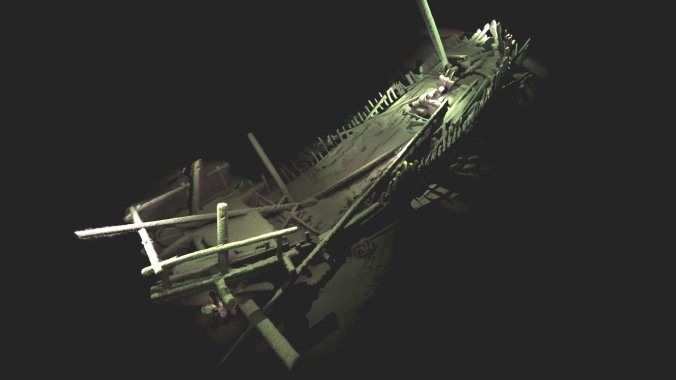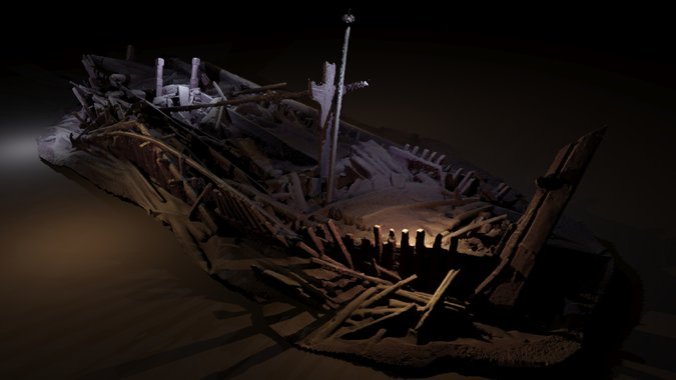
An image of the well-preserved medieval ship found at the bottom of the Black Sea, one of more than 40 wrecks discovered. Photogrammetry, a process using thousands of photographs and readings, produced a rendering that appears three-dimensional. Credit Expedition and Education Foundation/Black Sea MAP
For divers, as well as anyone fascinated by ancient maritime trade routes, this must be the best news in a long while:
‘We Couldn’t Believe Our Eyes’: A
Lost World of Shipwrecks Is FoundArchaeologists have found more than 40 vessels in the Black Sea, some more than a millennium old, shedding light on early empires and trade routes.
By
The medieval ship lay more than a half-mile down at the bottom of the Black Sea, its masts, timbers and planking undisturbed in the darkness for seven or eight centuries. Lack of oxygen in the icy depths had ruled out the usual riot of creatures that feast on sunken wood.
This fall, a team of explorers lowered a robot on a long tether, lit up the wreck with bright lights and took thousands of high-resolution photos. A computer then merged the images into a detailed portrait.
Archaeologists date the discovery to the 13th or 14th century, opening a new window on forerunners of the 15th- and 16th-century sailing vessels that discovered the New World, including those of Columbus. This medieval ship probably served the Venetian empire, which had Black Sea outposts.
Never before had this type of ship been found in such complete form. The breakthrough was the quarterdeck, from which the captain would have directed a crew of perhaps 20 sailors.
“That’s never been seen archaeologically,” said Rodrigo Pacheco-Ruiz, an expedition member at the Center for Maritime Archaeology at the University of Southampton, in Britain. “We couldn’t believe our

A photogrammetric image of a ship from the Ottoman era that most likely went down between the 17th and 19th centuries. The discoverers nicknamed it the Flower of the Black Sea because of its ornate carvings, including two large posts topped with petals. Credit Expedition and Education Foundation/Black Sea MAP
Remarkably, the find is but one of more than 40 shipwrecks that the international team recently discovered and photographed off the Bulgarian coast in one of archaeology’s greatest coups.
In age, the vessels span a millennium, from the Byzantine to the Ottoman empires, from the ninth to the 19th centuries. Generally, the ships are in such good repair that the images reveal intact coils of rope, rudders and elaborately carved decorations.
“They’re astonishingly preserved,” said Jon Adams, the leader of the Black Sea project and founding director of the maritime archaeology center at the University of Southampton.
Kroum Batchvarov, a team member at the University of Connecticut who grew up in Bulgaria and has conducted other studies in its waters, said the recent discoveries “far surpassed my wildest expectations.”
Independent experts said the annals of deepwater archaeology hold few, if any, comparable sweeps of discovery in which shipwrecks have proved to be so plentiful, diverse and well preserved…

A photogrammetric image of the stern of the Ottoman-era ship showing coils of rope and a tiller with elaborate carvings. A lack of oxygen at the icy depths of the Black Sea left the wrecks relatively undisturbed. Credit Expedition and Education Foundation/Black Sea MAP
“It’s a great story,” said Shelley Wachsmann of the Institute of Nautical Archaeology at Texas A&M University. “We can expect some real contributions to our understanding of ancient trade routes.”
Goods traded on the Black Sea included grains, furs, horses, oils, cloth, wine and people. The Tatars turned Christians into slaves who were shipped to places like Cairo. For Europeans, the sea provided access to a northern branch of the Silk Road and imports of silk, satin, musk, perfumes, spices and jewels.
Marco Polo reportedly visited the Black Sea, and Italian merchant colonies dotted its shores. The profits were so enormous that, in the 13th and 14th centuries, Venice and Genoa fought a series of wars for control of the trade routes, including those of the Black Sea.
Brendan P. Foley, an archaeologist at the Woods Hole Oceanographic Institution on Cape Cod, Mass., said the good condition of the shipwrecks implied that many objects inside their hulls might also be intact.
“You might find books, parchment, written documents,” he said in an interview. “Who knows how much of this stuff was being transported? But now we have the possibility of finding out. It’s amazing.”…